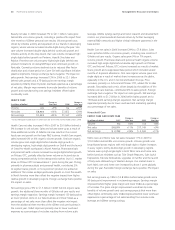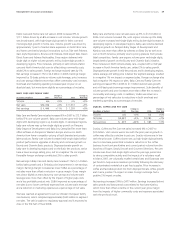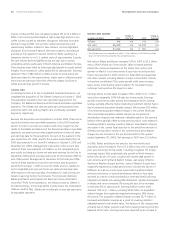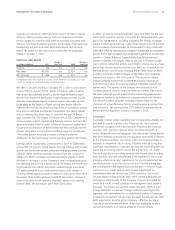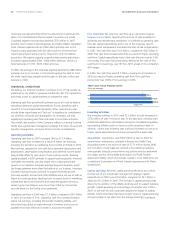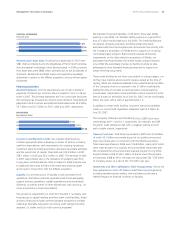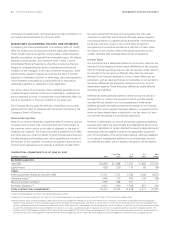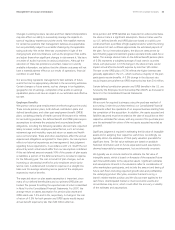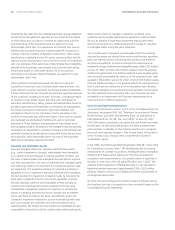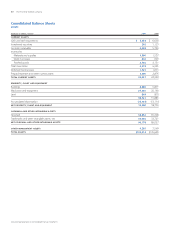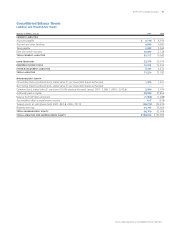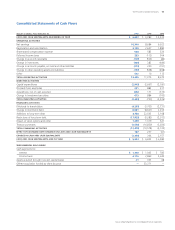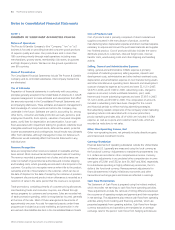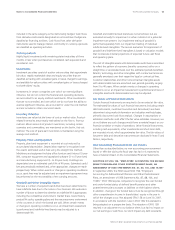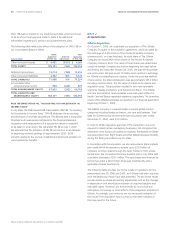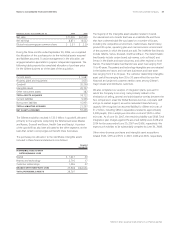Proctor and Gamble 2007 Annual Report Download - page 49
Download and view the complete annual report
Please find page 49 of the 2007 Proctor and Gamble annual report below. You can navigate through the pages in the report by either clicking on the pages listed below, or by using the keyword search tool below to find specific information within the annual report.The Procter & Gamble Company 47Management’s Discussion and Analysis
As a multinational company with diverse product offerings, we are
exposed to market risks such as changes in interest rates, currency
exchange rates and commodity prices. To manage the volatility related
to these exposures, we evaluate our exposures on a global basis to
take advantage of the direct netting opportunities and of currency,
interest rate and commodity correlations that exist within the portfolio.
For the remaining exposures, we enter into various derivative transactions
in accordance with the Company’s hedging policies that are designed
to partially, or entirely, offset changes in the underlying exposures
being hedged. We do not hold or issue derivative nancial instruments
for speculative trading purposes. Note 6 to the Consolidated Financial
Statements includes a detailed discussion of our accounting policies
for nancial instruments.
Derivative positions are monitored using techniques including market
valuation, sensitivity analysis and value-at-risk modeling. The tests for
interest rate, currency rate and commodity price exposures discussed
below are based on the CorporateManager™ value-at-risk model
using a one-year horizon and a 95% condence level. The model
incorporates the impact of correlation (the degree to which exposures
move together over time) and diversication (from holding multiple
currency, commodity and interest rate instruments) and assumes that
nancial returns are normally distributed. Estimates of volatility and
correlations of market factors are drawn from the RiskMetrics™
dataset as of June 30, 2007. In cases where data is unavailable in
RiskMetrics™, a reasonable proxy is included.
Our market risk exposures relative to interest rates, currency rates and
commodity prices, as discussed below, have not changed materially
versus the previous reporting period. In addition, we are not aware of
any facts or circumstances that would signicantly impact such
exposures in the near term.
Interest Rate Exposure. Interest rate swaps are used to hedge
exposures to interest rate movement on underlying debt obligations.
Certain interest rate swaps denominated in foreign currencies are
designated to hedge exposures to currency exchange rate movements
on our investments in foreign operations. These currency interest rate
swaps are designated as hedges of the Company’s foreign net
investments.
Based on our overall interest rate exposure as of and during the year
ended June 30, 2007, including derivative and other instruments
sensitive to interest rates, we believe a near-term change in interest
rates, at a 95% condence level based on historical interest rate
movements, would not materially affect our nancial statements.
Currency Rate Exposure. Because we manufacture and sell products
in a number of countries throughout the world, we are exposed to
the impact on revenue and expenses of movements in currency
exchange rates. The primary purpose of our currency hedging activities
is to reduce the risk that our nancial position will be adversely
affected by short-term changes in exchange rates. Corporate policy
prescribes the range of allowable hedging activity. We primarily use
forward contracts and options with maturities of less than 18 months.
In addition, we enter into certain currency swaps with maturities of
up to ve years to hedge our exposure to exchange rate movements
on intercompany nancing transactions. We also use purchased
currency options with maturities of generally less than 18 months and
forward contracts to hedge against the effect of exchange rate
uctuations on intercompany royalties and to offset a portion of the
effect of exchange rate uctuations on income from international
operations.
Based on our overall currency rate exposure as of and during the year
ended June 30, 2007, we believe, at a 95% condence level based
on historical currency rate movements, the impact of a near-term
change in currency rates on derivative and other instruments would
not materially affect our nancial statements.
Commodity Price Exposure. We use raw materials that are subject to
price volatility caused by weather, supply conditions, political and
economic variables and other unpredictable factors. In addition to
xed price contracts, we use futures, options and swap contracts to
manage the volatility related to the above exposures. The impact of
commodity hedging activity is not considered material to our nancial
statements.
Measures Not Defined By U.S. GAAP
Our discussion of nancial results includes several “non-GAAP” nancial
measures. We believe these measures provide our investors with
additional information about our underlying results and trends, as
well as insight to some of the metrics used to evaluate management.
When used in MD&A, we have provided the comparable GAAP
measure in the discussion. These measures include:
Organic Sales Growth. Organic sales growth measures sales growth
excluding the impacts of foreign exchange, acquisitions and divestitures
from year-over-year comparisons. The Company believes this provides
investors with a more complete understanding of underlying results
and trends by providing sales growth on a consistent basis.



